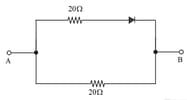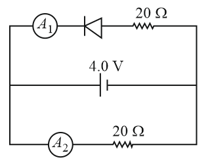S. L. Arora Solutions for Chapter: Semiconductor Devices and Digital Circuits, Exercise 3: Problems For Practice
S. L. Arora Physics Solutions for Exercise - S. L. Arora Solutions for Chapter: Semiconductor Devices and Digital Circuits, Exercise 3: Problems For Practice
Attempt the free practice questions on Chapter 6: Semiconductor Devices and Digital Circuits, Exercise 3: Problems For Practice with hints and solutions to strengthen your understanding. PHYSICS A Reference Book for Class 12 Volume 2 solutions are prepared by Experienced Embibe Experts.
Questions from S. L. Arora Solutions for Chapter: Semiconductor Devices and Digital Circuits, Exercise 3: Problems For Practice with Hints & Solutions
Find the current through the circuit and the potential difference across the diode shown in figure. The drift current for the diode is .
Find the equivalent resistance of the circuit shown in figure between points and , for

Assuming that the resistances of the meters are negligible, what will be the readings of the ammeters and in the circuit shown in figure?
A potential barrier of exists across a - junction. (i) If the depletion region is thick, what is the intensity of the electric field in this region? (ii) If an electron with speed approaches the - junction from the -side, with what speed will it enter the -side? Mass of electron, , charge of the electron,
A sinusoidal voltage of rms value is applied to a diode and a resistor in the circuit shown in figure, so that half-wave rectification occurs. If the diode is ideal, what is the rms voltage across ?

The applied input A.C to a half-wave rectifier is The D.C output is . (i) What is the rectification efficiency? (ii) What is the power efficiency?
A crystal diode having internal resistance is used as a half rectifier. If the applied voltage is volt and load resistance is , find (i) maximum output current (ii) d. c. output current (iii) d. c. output power and (iv) d. c. output voltage.
In a photodiode, the conductivity increases when the material is exposed to light. It is found that conductivity changes only if the wavelength is less than What is the band gap?

